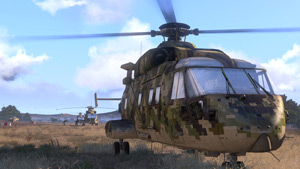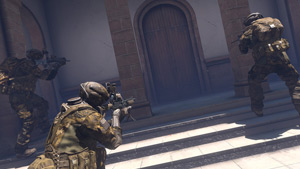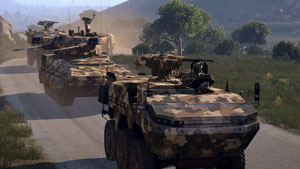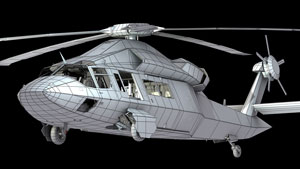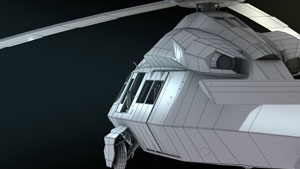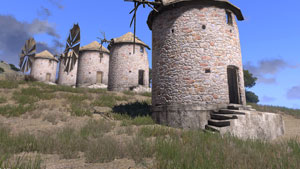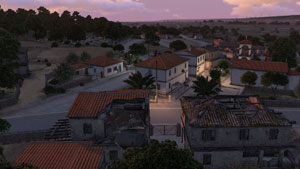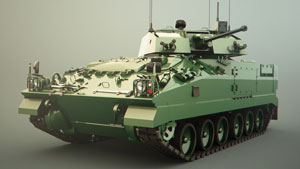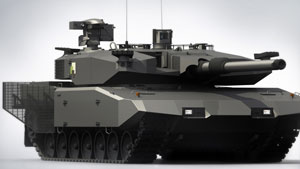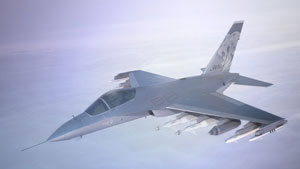As someone who has had a major hand in bringing Arma 3’s stunning visuals to life, we’ve asked Artist Lead Dave Zapletal to Report In™ on the artistic side of things.
We're often asked to let some of our people talk about what it's like to develop a game at BI. 'Report In!' gives you a more personal perspective on our team, a more detailed look at the way we go about our work, and fresh information about our ongoing projects.
Leading a splendid team of artists, Dave oversees the creation of art assets, ensuring the quality and consistency, and making sure everything is done on time. From concepts, to modelling, texturing, and the final ‘spit ‘n polish’, it’s a thorough process – and to find out more about the things involved, we signed on Dave for our latest Report In dev interview.
Introduction
Tell the people a little about yourself. What's your role? How long have you been with Bohemia Interactive? Which projects have you contributed to and what is your favorite BI game or mission?
[thumb class="pull-left" clear-xs]Dave_ReportIn.jpg[/thumb] Hi there, my name is David Zapletal and I’m the Artist Lead on Arma 3. I’ve been working in the game industry since 1998, starting out as a 3D artist. Over the years, I’ve worked on titles such as Original War and the UFO series, which were published under the Altar Games flag. Later, when Altar Games joined forces with Bohemia Interactive, I went to work on Arma 2, leading a team of supporting artists. Once we finished Arma 2, we continued working on the Arma 2: Operation Arrowhead and Arma 2: British Armed Forces standalone expansions. All in all, while Arma 3 is certainly my biggest project so far, I would say my favorite project within BI is still the British Armed Forces DLC for Arma 2. It really enabled us to focus on one topic, and I simply fell in love with the visually appealing design of the British forces. However, with its many exciting artistic challenges, Arma 3 is definitely a close second.
And can you give us a random fact about yourself?
I’ve travelled through India, which you could say has really opened my eyes. I could recommend any Westerner to visit the East, and vice versa. Both cultures have lots to learn from each other.
Fresh Paint
Let’s start with the very beginning. How does the development of a game, such as Arma 3, start for the Art department?
The development of Arma 3 has been quite an adventure. I still remember the moment my phone was ringing. It was Ivan Buchta, Arma 3’s Creative Director at the time, asking me whether I had a moment. That moment turned into a 10-kilometer walk around the room, talking to each other on the phone. I think it was just a few days later when we were standing in the office, holding a list of assets, sorted into categories, priorities, and complexity, and presenting it to the team. Of course this was only a way to kick things off. Many assets were added, or even removed, later – based on the requests from our Design team.
[thumb class="pull-left" clear-xs]art_house.jpg[/thumb] But to be a bit more specific as to what goes on within the Art department, I usually begin by discussing a proposal for a vehicle, weapon, or other asset, with my Art team. This generates a lot of ideas. I’ll be flooded with feedback, but it’s an essential phase in the process, because the dialogue brings a lot of motivation and a sense of anticipation. Then comes the ‘real’ work, which begins by searching for materials, discussing the functions of an asset, and all of its possible variants. Based on this we’ll prepare concept sketches, and the next step is creating the first prototype.
However, before I go too much into detail, I should also point out that producing game visuals is often a very analytical task, rather than a creative plaything. Even though renders on their own just need to look good, a game is an interactive medium, meaning that each asset should behave correctly and respond to a player’s actions. And, as you might expect, this requires a lot of co-operation between all of our departments.
So which art disciplines are involved in creating a game like Arma 3?
Basically everything you see, starting with the box-art, and ending with the last letter in the credits, should have gone through the Art department. The artists are either the direct creators or consultants when it comes to these aspects of the game. While I might be forgetting some of the roles, let’s name a few: 3D modeling, texturing, creating tools for porting assets into the engine, drawing artwork, designing logos, typography, concepts, icon design, and web and other marketing assets. However, these things are not just done by us; it always comes down to a collaborative effort of departments/people in our studio.

To put things into perspective, could you briefly explain how, let’s say, an Arma 3 helicopter is created?
After the Sandbox Design team has presented their vision for the helicopter, we start by searching for reference materials. Our goal is to make the Armaverse as authentic as possible. This means we need to gather a wide range of materials from the Internet, military expos and magazines, and sometimes request help from military advisors. The latter really helps us cover the vast spectrum of military knowledge that is often required. Eventually, the collected information serves as the foundation for the various shapes, sizes, curves, used materials, weathering, moving parts and detailed symbols/marks of the helicopter. A 3D artist then sets up a prototype, defining the basic shapes and dimensions. This prototype will be sent for validation to the Sandbox designers, and will serve as a placeholder in the game before the actual 3D model is delivered.
The model is delivered in several layers of detail. The interiors are the most detailed, since these are closer to the player’s point of view. Other layers are the exteriors displayed from various distances. Of course, on top of the visual models, the 3D artist also creates several utility models, which are used for the interaction with the game environment, such as a collision model for obstacles, fire geometry for penetration, a shadow model, model for AI detection and a model that defines all the axes from the control elements in the interior to the main rotor axis.
The core model is then given to a 2D artist, who will create the textures. He has to study the information and materials even more thoroughly, as all the details need to appear as precisely as possible on the texture. He also creates the utility textures, such as a heat map for different types of imaging. Then he sets up the materials to behave naturally in various weather and lighting conditions, and delivers the icons for the helicopter which will be displayed in the map and in-game interface. Once this is delivered, we transfer the helicopter to the Encoding department, who incorporate it into the game and set all of the characteristics in the process. When this is done, we co-operate with the QA department to finish the visuals and fix any bugs. All in all, the entire process can take several weeks or even months.
With almost every new Arma game, graphics take a significant leap forward – increasing the polygon count and overall level of detail. What does this mean for the artists?
With each new game we want to push visuals to new heights. As such, the Art department is always looking for ways to improve the visual quality, which often goes hand in hand with improvements to the engine. Obviously a higher level of detail means more work for the artists per task. On the other hand, we still also need to think about how the increased details on models or textures will affect the performance of the game. We constantly test this on a large scale.
A Mediterranean Palette
Compared to Arma 2 (and its standalone expansions), Arma 3 has a very distinct look. What is the main difference?
I think the most significant difference relates to the lighting. Arma 3 has much more contrast and therefore appears more colorful. The scene is brighter, for example, when compared to Arma 2, which was more hazed.
While the Chernarus environment in Arma 2 was inspired by Czech landscape, the islands of Altis and Stratis are Mediterranean destinations. What does this mean for artists?
The climate, plants, buildings, colors and richness have been carefully represented in the game. With our goal to deliver an authentic environment, this was not easy and took longer than expected. It’s definitely much more of a challenge when you’re not able to re-visit the place and try out the conditions we needed – as it was the case for us with the Chernarus environment.
What kind of reference materials do you use, and where do you get them from?
For inspiration, we mostly use public channels such as the Internet, maps, documentaries and photos. Of course, a personal experience in the environment, or trying out vehicles on some expo, is even more beneficial. For this reason, I and a colleague also visited Lemnos to learn how the Mediterranean climate affects vegetation, colors and lighting of the environment. We carefully studied the architecture of local villages. Obviously, this was before the ‘Limnos incident’.
The devil is often in the details – especially in games. Could you mention one or a few examples which add a lot to the Arma 3’s (visual) atmosphere?
Arma 3 has many detailed textures, which are not the primary focus, but I think they do often get noticed thanks to Arma’s slower gameplay. Vegetation, including the grass, now has much more detail, which makes it seem more abundant and natural. We also changed the range of light sources. They are now more intense but attenuate faster with the distance, which makes them appear warmer.
The Future Is Bright
Arma 3 is set in the near future, and thus includes fictional weapons and vehicles and/or prototypes. How did you take advantage of this additional creative liberty?
Even though it’s fictional, we still need to make it believable, authentic. Every gun or vehicle part is created with a purpose, and when we want to change something, we need to carefully consider its functional purpose. This binds us more than other games which are not pushing for this level of authenticity. Nevertheless, it was fun to study the current technology employed in prototype models, and think about the new manufacturing methods regarding shapes and materials.
While Arma 3 was released in September, new (free) content is still coming out – also in support of the campaign episodes. What can you tell us, for instance, about the most recent batch of new vehicles?
The new tank boosting the AAF faction is inspired by the German Leopard 2. It was developed with a lot of passion, as we were really looking forward to play with it ourselves. The same goes for the APC, which had already made an appearance in the BAF DLC, but the model was re-created in higher detail to fit Arma 3’s standards. In the future, there will also be more close air support planes, which we know are highly anticipated by the fans. They play a large role in the gameplay on Altis, so we’ll be looking forward to implementing them and delivering the additional punch.
Do you have a favorite art asset (can be anything) in Arma 3?
I can’t pick one, I’m in love with every asset which is perfectly tuned and fits in flawlessly. Sometimes even a bit too much, which results in me obsessing over an asset, even while I’m engaged in deadly multiplayer combat. This also extends beyond the official content. I continue to be amazed by what Arma fans are able to create.
General questions
And after a long day of making games, what do you like to do to relax and unwind?
I enjoy hiking whenever possible (and leaving the world of technology behind). But, very opposite to this, I also have a deep passion for motorcycle racing, I love that smell of gasoline and burned rubber.
For those looking to become game artists, which skills and software should they master, and where should they start?
Of course you should acquire skills in 3D editor (3D Max, Modo, Maya) and 2D editor (Photoshop or at least MS Paint) software, but you should primarily focus on the game itself. Only then will you be able to understand the reasons, requirements and restrictions of some tasks. Patience helps a lot, as compared to other software, the time spent on developing games tends to be longer and comes with its own set of rules. For Arma games specifically, a lot of attention to detail is required.
A newly discovered Mayan prophecy hints at the occurrence of a video game apocalypse in 2014. As a firm believer, you sign up to become the official guardian of your favorite game. Which one would that be?
Forgive me for my perhaps ‘spiritual’ answer (I am a Mayan follower after all), but I would protect ‘the game of life’ (with my life). You know, that game with unlimited objectives to fulfill, and levels to reach. For me it still has the best force-feedback, rendering engine, and of course multiplayer.
